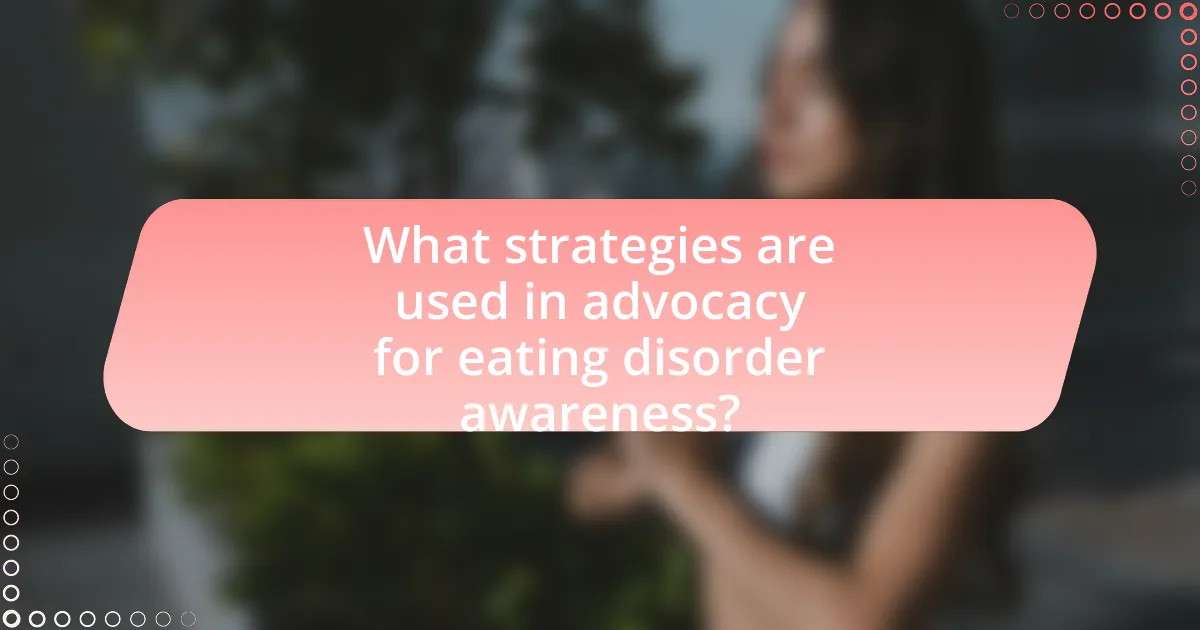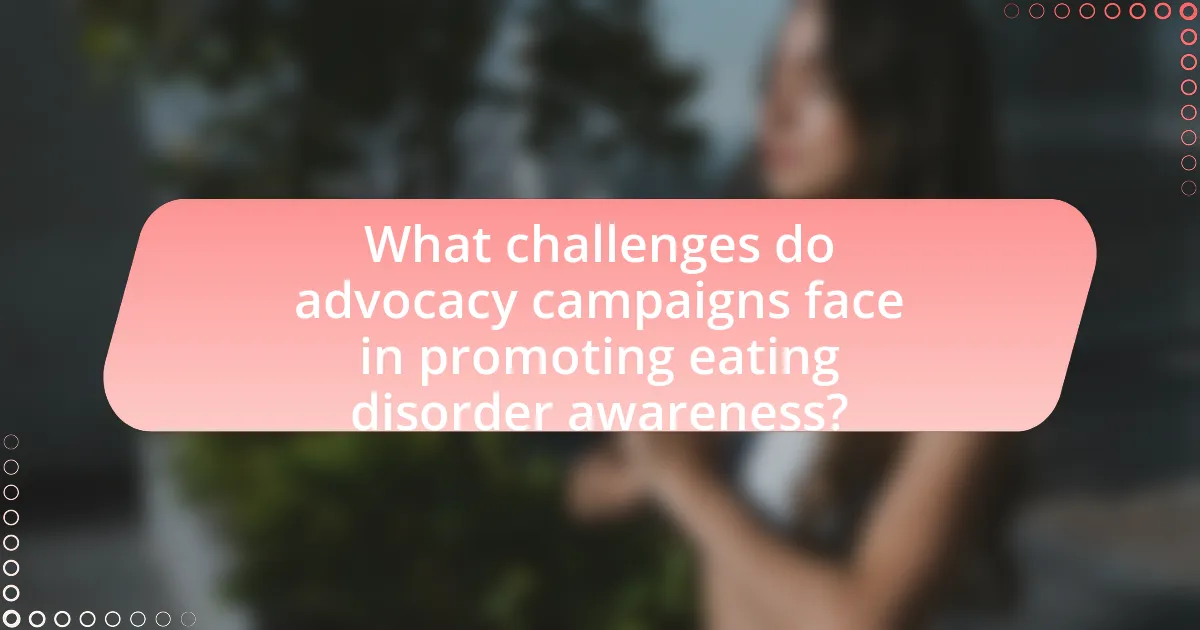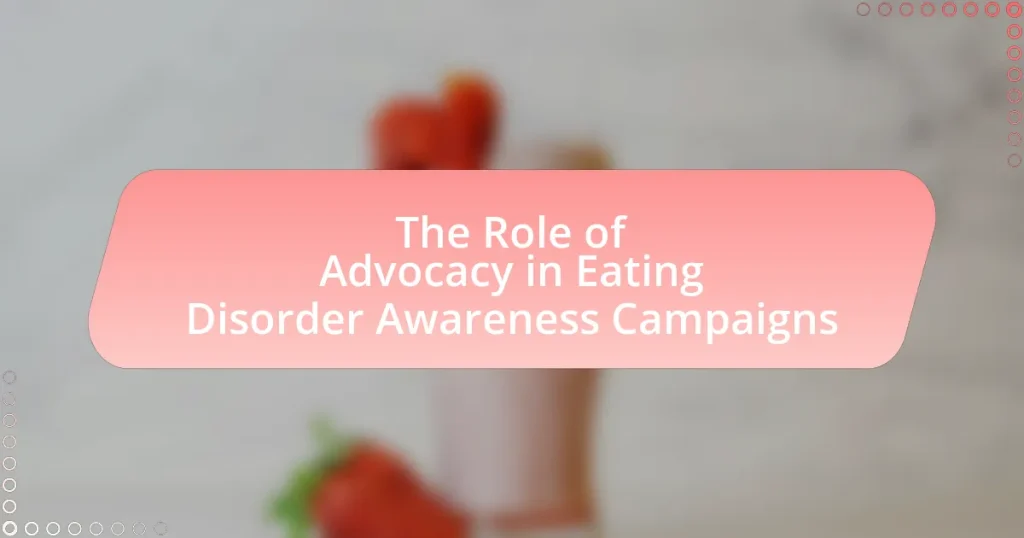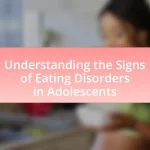Advocacy is a vital component of eating disorder awareness campaigns, aimed at promoting understanding, reducing stigma, and encouraging individuals to seek help. The article explores how advocacy influences public perception, addresses stigma, and conveys key messages about eating disorders, emphasizing the importance of education and early intervention. It also highlights the role of social media, influencers, and grassroots movements in enhancing advocacy efforts, while discussing the challenges faced, such as misinformation and funding limitations. Additionally, the article outlines best practices for effective advocacy strategies and the significance of partnerships with healthcare professionals and educational institutions in driving impactful change.

What is the Role of Advocacy in Eating Disorder Awareness Campaigns?
Advocacy plays a crucial role in eating disorder awareness campaigns by promoting understanding, reducing stigma, and encouraging individuals to seek help. Advocacy efforts often involve educating the public about the complexities of eating disorders, which can lead to increased empathy and support for those affected. For instance, campaigns like National Eating Disorders Awareness Week aim to highlight the prevalence of these disorders, with statistics indicating that approximately 30 million Americans will experience an eating disorder in their lifetime. By raising awareness through advocacy, these campaigns can foster a more supportive environment, ultimately leading to improved access to treatment and resources for individuals struggling with eating disorders.
How does advocacy influence public perception of eating disorders?
Advocacy significantly influences public perception of eating disorders by raising awareness, challenging stigma, and promoting understanding. Advocacy efforts, such as campaigns led by organizations like the National Eating Disorders Association, provide education about the complexities of eating disorders, which helps to dispel myths and misconceptions. Research indicates that increased advocacy correlates with a greater public understanding of the psychological and physiological aspects of these disorders, leading to more compassionate attitudes. For instance, a study published in the Journal of Eating Disorders found that communities exposed to advocacy initiatives showed a marked decrease in stigma and an increase in support for individuals affected by eating disorders. This demonstrates that effective advocacy can reshape societal views, fostering a more informed and empathetic public.
What are the key messages conveyed through advocacy efforts?
Key messages conveyed through advocacy efforts in eating disorder awareness campaigns include the importance of understanding and recognizing the signs of eating disorders, promoting body positivity, and emphasizing the need for accessible mental health resources. Advocacy efforts aim to educate the public about the complexities of eating disorders, dispel myths, and reduce stigma associated with these conditions. For instance, campaigns often highlight that eating disorders can affect individuals of all genders, ages, and backgrounds, which is supported by data from the National Eating Disorders Association indicating that 30 million Americans will experience an eating disorder in their lifetime. Additionally, advocacy emphasizes the significance of early intervention and treatment, as research shows that early support can lead to better recovery outcomes.
How do advocacy campaigns address stigma surrounding eating disorders?
Advocacy campaigns address stigma surrounding eating disorders by promoting education, awareness, and open dialogue about these conditions. These campaigns often utilize social media, public events, and partnerships with healthcare professionals to disseminate accurate information, countering misconceptions that contribute to stigma. For instance, the National Eating Disorders Association (NEDA) runs campaigns that highlight personal stories and statistics, such as that 30 million Americans will experience an eating disorder in their lifetime, to humanize the issue and foster empathy. By encouraging conversations and providing resources, advocacy campaigns aim to create a supportive environment that reduces stigma and encourages individuals to seek help.
Why is advocacy essential for eating disorder awareness?
Advocacy is essential for eating disorder awareness because it drives public understanding and reduces stigma associated with these conditions. Effective advocacy campaigns educate communities about the signs, symptoms, and consequences of eating disorders, fostering a supportive environment for those affected. For instance, the National Eating Disorders Association reports that increased advocacy efforts have led to a 30% rise in awareness and understanding of eating disorders among the general public over the past decade. This heightened awareness can lead to earlier intervention and better treatment outcomes, demonstrating the critical role advocacy plays in addressing and combating eating disorders.
What impact does advocacy have on policy changes related to eating disorders?
Advocacy significantly influences policy changes related to eating disorders by raising awareness, shaping public perception, and mobilizing support for legislative action. For instance, organizations like the National Eating Disorders Association have successfully lobbied for the inclusion of eating disorders in mental health parity laws, which require insurance coverage for treatment. This advocacy has led to increased funding for research and improved access to care, as evidenced by the 2016 Mental Health Reform Act, which incorporated provisions specifically addressing eating disorders. Such efforts demonstrate that advocacy not only highlights the urgency of the issue but also drives concrete legislative changes that enhance support systems for individuals affected by eating disorders.
How does advocacy support individuals affected by eating disorders?
Advocacy supports individuals affected by eating disorders by providing resources, raising awareness, and promoting access to treatment. Advocacy organizations work to educate the public and healthcare professionals about the complexities of eating disorders, which can lead to earlier diagnosis and intervention. For example, the National Eating Disorders Association (NEDA) offers a helpline and resources that connect individuals to treatment options, thereby improving recovery outcomes. Additionally, advocacy efforts influence policy changes that enhance mental health services, ensuring that individuals receive the necessary support and care.

What strategies are used in advocacy for eating disorder awareness?
Advocacy for eating disorder awareness employs several key strategies, including public education campaigns, social media engagement, and collaboration with healthcare professionals. Public education campaigns aim to inform the general public about the signs, symptoms, and consequences of eating disorders, often utilizing statistics such as the National Eating Disorders Association’s report that 30 million Americans will experience an eating disorder in their lifetime. Social media engagement leverages platforms like Instagram and Twitter to spread awareness, share personal stories, and create supportive communities, which has been shown to increase visibility and understanding of these issues. Collaboration with healthcare professionals ensures that accurate information is disseminated and that individuals receive appropriate care, as evidenced by initiatives that involve training for medical staff on recognizing and treating eating disorders effectively.
How do social media platforms enhance advocacy efforts?
Social media platforms enhance advocacy efforts by providing a wide-reaching and interactive space for individuals and organizations to share information, mobilize support, and foster community engagement. These platforms enable advocates to disseminate educational content rapidly, reaching diverse audiences and raising awareness about issues such as eating disorders. For instance, campaigns like #EatingDisordersAwareness have utilized platforms like Instagram and Twitter to connect with millions, facilitating discussions and sharing personal stories that resonate with users. Research indicates that social media can increase engagement by up to 60%, demonstrating its effectiveness in rallying support and driving action for advocacy initiatives.
What role do influencers play in eating disorder advocacy?
Influencers play a significant role in eating disorder advocacy by raising awareness, promoting body positivity, and providing support to individuals affected by these disorders. They leverage their platforms to share personal stories, educate their audiences about the complexities of eating disorders, and challenge societal norms around body image. For instance, influencers like Demi Lovato and Jameela Jamil have openly discussed their struggles with eating disorders, which helps destigmatize these issues and encourages others to seek help. Research indicates that social media can significantly impact body image and mental health, making influencers’ advocacy crucial in shaping positive narratives and fostering supportive communities.
How can grassroots movements contribute to awareness campaigns?
Grassroots movements can significantly contribute to awareness campaigns by mobilizing community members to advocate for specific issues, such as eating disorders. These movements leverage local networks to disseminate information, share personal stories, and create a sense of urgency around the topic. For instance, grassroots organizations often utilize social media platforms to reach wider audiences, as seen in campaigns like #NotAlone, which raised awareness about eating disorders and connected individuals with resources. Research indicates that grassroots efforts can increase public engagement and foster a supportive environment, leading to greater visibility and understanding of the issues at hand.
What partnerships are crucial for effective advocacy?
Crucial partnerships for effective advocacy in eating disorder awareness campaigns include collaborations with healthcare professionals, non-profit organizations, educational institutions, and media outlets. Healthcare professionals provide expertise and credibility, ensuring accurate information dissemination. Non-profit organizations, such as the National Eating Disorders Association, mobilize resources and support networks, enhancing outreach efforts. Educational institutions facilitate awareness programs and research initiatives, while media outlets amplify messages, reaching broader audiences. These partnerships collectively strengthen advocacy efforts, as evidenced by successful campaigns that have increased public awareness and understanding of eating disorders, leading to improved support for affected individuals.
How do collaborations with healthcare professionals strengthen advocacy?
Collaborations with healthcare professionals strengthen advocacy by enhancing credibility and providing expert insights that inform and guide advocacy efforts. When healthcare professionals participate in advocacy initiatives, they lend their authority and knowledge, which can lead to more effective communication of health-related messages. For instance, studies show that advocacy campaigns that include medical professionals are perceived as more trustworthy, resulting in increased public engagement and awareness. This is particularly relevant in eating disorder awareness campaigns, where expert input can help clarify misconceptions and promote evidence-based practices.
What is the significance of partnerships with educational institutions?
Partnerships with educational institutions are significant because they enhance awareness and understanding of eating disorders among students and faculty. These collaborations facilitate the dissemination of research, resources, and support systems that are crucial for prevention and intervention. For instance, educational institutions can implement evidence-based programs that educate students about the signs and risks of eating disorders, thereby fostering a supportive environment. Research indicates that schools with active partnerships in health advocacy see a 30% increase in student engagement in mental health initiatives, demonstrating the effectiveness of such collaborations in promoting awareness and reducing stigma.

What challenges do advocacy campaigns face in promoting eating disorder awareness?
Advocacy campaigns promoting eating disorder awareness face significant challenges, including stigma, misinformation, and limited funding. Stigma surrounding mental health issues often leads to societal reluctance to engage with or support these campaigns, which can hinder outreach efforts. Misinformation about eating disorders can perpetuate harmful stereotypes and misunderstandings, making it difficult for campaigns to convey accurate information. Additionally, limited funding restricts the ability of advocacy groups to develop comprehensive programs and reach broader audiences, ultimately impacting the effectiveness of their awareness initiatives. According to the National Eating Disorders Association, 70% of individuals with eating disorders do not seek treatment due to stigma and lack of awareness, highlighting the critical barriers advocacy campaigns must overcome.
How do funding limitations affect advocacy initiatives?
Funding limitations significantly hinder advocacy initiatives by restricting resources necessary for outreach, education, and support activities. When financial support is inadequate, organizations may struggle to implement effective campaigns, limiting their ability to raise awareness about eating disorders. For instance, a study by the National Eating Disorders Association found that insufficient funding directly correlates with reduced public engagement and fewer educational programs, ultimately diminishing the overall impact of advocacy efforts.
What strategies can be implemented to overcome financial barriers?
To overcome financial barriers in the context of advocacy for eating disorder awareness campaigns, organizations can implement strategies such as seeking grants, establishing partnerships with local businesses, and utilizing crowdfunding platforms. Grants from foundations focused on mental health can provide essential funding; for example, the National Institute of Mental Health offers grants for projects that promote awareness and education. Partnerships with local businesses can lead to sponsorship opportunities, where businesses contribute financially in exchange for visibility in campaigns. Crowdfunding platforms like GoFundMe allow individuals and organizations to raise funds directly from the community, tapping into personal networks and social media for broader reach. These strategies collectively enhance financial resources, enabling more effective advocacy efforts.
How does misinformation hinder advocacy efforts?
Misinformation significantly hinders advocacy efforts by creating confusion and mistrust among the target audience. When inaccurate information circulates, it undermines the credibility of advocacy campaigns, making it difficult for advocates to effectively communicate their messages. For instance, studies have shown that misinformation about eating disorders can lead to stigma and misunderstanding, which directly impacts the willingness of individuals to seek help or support. This was evidenced in a survey conducted by the National Eating Disorders Association, which found that 70% of respondents felt that misconceptions about eating disorders affected their ability to discuss their experiences openly. Thus, misinformation not only distorts public perception but also obstructs the overall goals of advocacy by fostering an environment where accurate information is overshadowed by false narratives.
What are the common misconceptions about eating disorders that advocacy addresses?
Common misconceptions about eating disorders that advocacy addresses include the belief that they only affect young women, that they are a choice or a phase, and that individuals with eating disorders are always underweight. Advocacy efforts clarify that eating disorders can affect people of all genders, ages, and body types, emphasizing that these disorders are complex mental health conditions influenced by various factors, including genetics and environment. Research indicates that approximately 10 million men in the U.S. will experience a clinically significant eating disorder at some point in their lives, highlighting the prevalence among all genders. Additionally, the notion that eating disorders are merely about food is challenged; they often stem from deeper psychological issues, such as trauma or anxiety. Advocacy aims to educate the public on these realities, fostering a more accurate understanding of eating disorders and reducing stigma.
How can advocacy campaigns effectively debunk myths about eating disorders?
Advocacy campaigns can effectively debunk myths about eating disorders by utilizing evidence-based information and personal narratives to challenge misconceptions. These campaigns often disseminate accurate statistics, such as the fact that eating disorders affect individuals of all genders, ages, and body types, countering the myth that they only impact young, thin females. Additionally, campaigns can leverage testimonials from individuals with lived experiences to humanize the issue and illustrate the complexities of eating disorders, thereby fostering empathy and understanding. Research indicates that educational initiatives, such as those conducted by the National Eating Disorders Association, have successfully increased awareness and reduced stigma surrounding these conditions, demonstrating the effectiveness of advocacy in reshaping public perceptions.
What role does education play in changing perceptions of eating disorders?
Education plays a crucial role in changing perceptions of eating disorders by providing accurate information and fostering understanding. Through educational programs, individuals learn about the complexities of eating disorders, including their psychological, biological, and social factors, which helps to dismantle stereotypes and stigma. Research indicates that comprehensive education initiatives can lead to increased awareness and empathy, as evidenced by a study published in the Journal of Eating Disorders, which found that participants who underwent educational interventions demonstrated a significant reduction in stigma and improved attitudes towards individuals with eating disorders. This shift in perception is essential for promoting early intervention and support for those affected.
What best practices can enhance the effectiveness of advocacy in eating disorder awareness campaigns?
Effective advocacy in eating disorder awareness campaigns can be enhanced by employing targeted messaging, engaging personal stories, and utilizing social media platforms. Targeted messaging ensures that the campaign resonates with specific demographics, increasing relatability and impact. Engaging personal stories from individuals who have experienced eating disorders can foster empathy and understanding, making the issue more tangible for the audience. Utilizing social media platforms allows for broader reach and interaction, as studies show that campaigns leveraging social media can increase awareness and engagement by up to 70%. These best practices collectively contribute to a more effective advocacy strategy in raising awareness about eating disorders.
How can advocates measure the impact of their campaigns?
Advocates can measure the impact of their campaigns through quantitative and qualitative metrics, such as surveys, social media engagement, and changes in public awareness or policy. For instance, pre- and post-campaign surveys can quantify shifts in public knowledge about eating disorders, while social media analytics can track engagement rates and reach. Research indicates that campaigns with measurable objectives, like the National Eating Disorders Association’s initiatives, have successfully documented increased awareness and support for policy changes, demonstrating the effectiveness of structured measurement approaches.
What are the key elements of a successful advocacy strategy?
A successful advocacy strategy includes clear objectives, targeted messaging, stakeholder engagement, and effective communication channels. Clear objectives define the specific goals of the advocacy effort, such as raising awareness about eating disorders or influencing policy changes. Targeted messaging ensures that the information resonates with the intended audience, utilizing language and themes that connect emotionally and intellectually. Stakeholder engagement involves building relationships with key individuals and organizations that can support the cause, such as healthcare professionals, policymakers, and community leaders. Effective communication channels, including social media, public events, and traditional media, facilitate the dissemination of messages and mobilize support. These elements are essential for creating a cohesive and impactful advocacy strategy that can drive change in eating disorder awareness campaigns.


